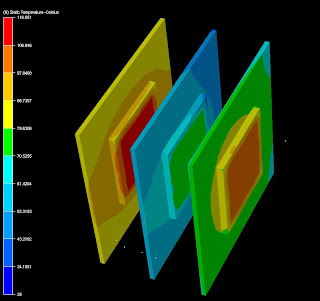
Thermal management is a critical issue in macro LED lighting industry since the high P-N junction temperature has several adverse effects as listed below:
1) High junction temperature can reduce the luminous efficacy (lumens/watts)
2) reduced forward voltage
3) shifted the dominant wavelength (nm). As the wavelength shifts, the color of the LED light will change accordingly. In the LED UV curing process, it is crucial to produce steady wavelengths in order to have tight control of the curing process
4) Reduced the lifetime of LED
The operating window of the LED is relatively small as it operates between the ambient (25 degC) to about 100 degC. The primary mechanism for heat transfer from the junction to the heat sink is conduction, while the removal of heat from the heat sink surface is by free convection or forced convection. It is important to keep in mind that the junction temperature will be affected by the rate-limiting step of the entire heat transfer mechanism.
A thermal model can be made with the electric circuit analogy, in which thermal resistance is modeled as a resistor, temperature is modeled as voltage source, and power consumption is modeled as current source. And the famous ohm's law states V2 = V1 + R*I, which leads to the thermal model of:
Tj = Ta + Rja * Pd
where Tj: the junction temp [degC]
Ta: the ambient temp [degC]
Rja: the overall thermal resistance from the junction to the exterior surface of the package
Pd: Power dissipated by the LED
The overall thermal resistance is the summation of:
Rja = Rjc + Rcb + Rtim + Rhs
where Rjc: thermal resistance between the junction to the ceramic substrate [C/W]
Rcb: thermal resistance between the ceramic substrate to the PCB board [C/W]
Rtim: thermal resistance for thermal interface material [C/W]
Rhs: thermal resistance of the heat sink [C/W]
Point 1 - what is thermal resistance? it is essentially Q=delT/R; where Q is [W], R is [C/W], and delT[C].
Hence, for the same value of Q, the higher the thermal resistance; the higher the temperature gradient between the two ends. It is therefore important to minimize Rja in the LED package design in order to reduce the junction temp.
Point 2 - what is the total power consumed by the LED? according to the ohm's law, it is P=I^2*R or P=I*V.
Point 3 - combining Point 1 and 2, for a given dissipated power by the LED (Pd), the delT between the junction and the ambient is the product of dissipated power and the overall thermal resistance.




The thermal management can be dealt with from the FEA numerical simulation perspectives. And the first basic question that I asked myself is:
Q: "for a given LED package, what is the minimum heat transfer coefficient required for ensuring that the junction temperature is maintained at X? A: Assumptions:
* Assume that A simplified LED package consists of 4.5W LED, a PCB board, and a conventional aluminum heat sink.
* The heat sink is 32mm by 25mm; please refer to the graph for dimensions.
* assume the surrounding air is at 30 degC.
After running the FEA model, the relationship between the junction temperature [C] and the heat transfer coefficient [(W/m^2-K] is plotted for 4.5W, 6.5W, and 8.5W LEDs as shown in the graph. The graph shows that the junction temperature will decrease rapidly with increasing the HTC value, but the rate of change of the junction temperature will gradually become flatter as it moves from the low HTC value to the higher one. This is an interesting point for the product design because it implies that the reduction in the junction temperature will become much difficult to do as the junction temperature approaches near the ambient.
Another interesting point is that the band of the curves becomes narrower as the HTC value increases. In other words, the jump in the junction temperature due to the increase in the power dissipation will decrease with increasing the HTC value. For example, at HTC=20 W/m^2-K, the jump in the junction temperature is from 72 degC to 108 degC (the difference is 36 degC) when the power increases from 4.8W to 8.5W. However, at HTC=80 W/m^2-K, the jump is from 44 degC to 60 degC (the difference is 16 degC) for the same power increase.





















